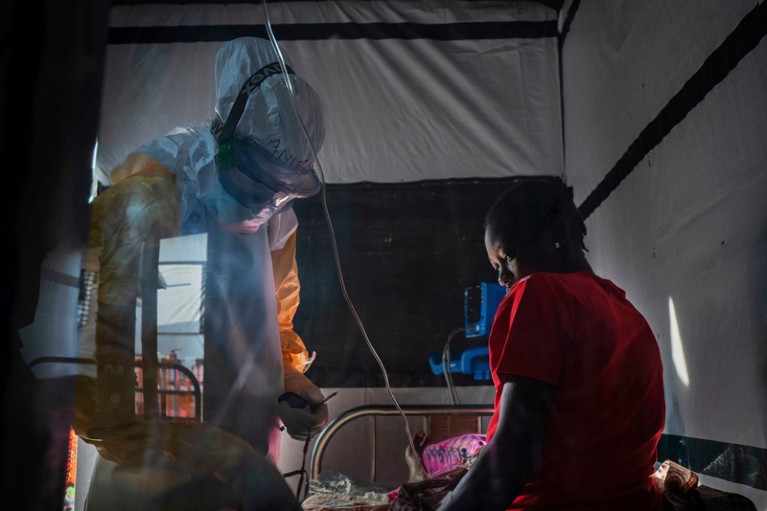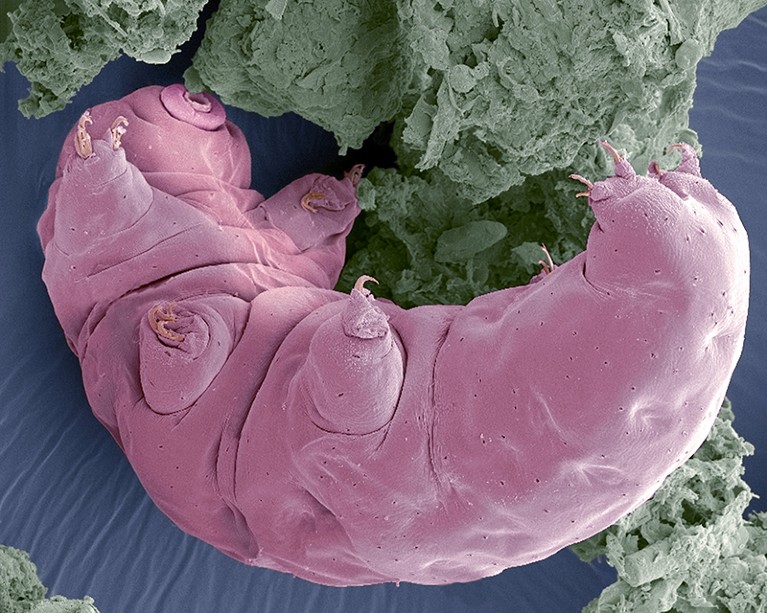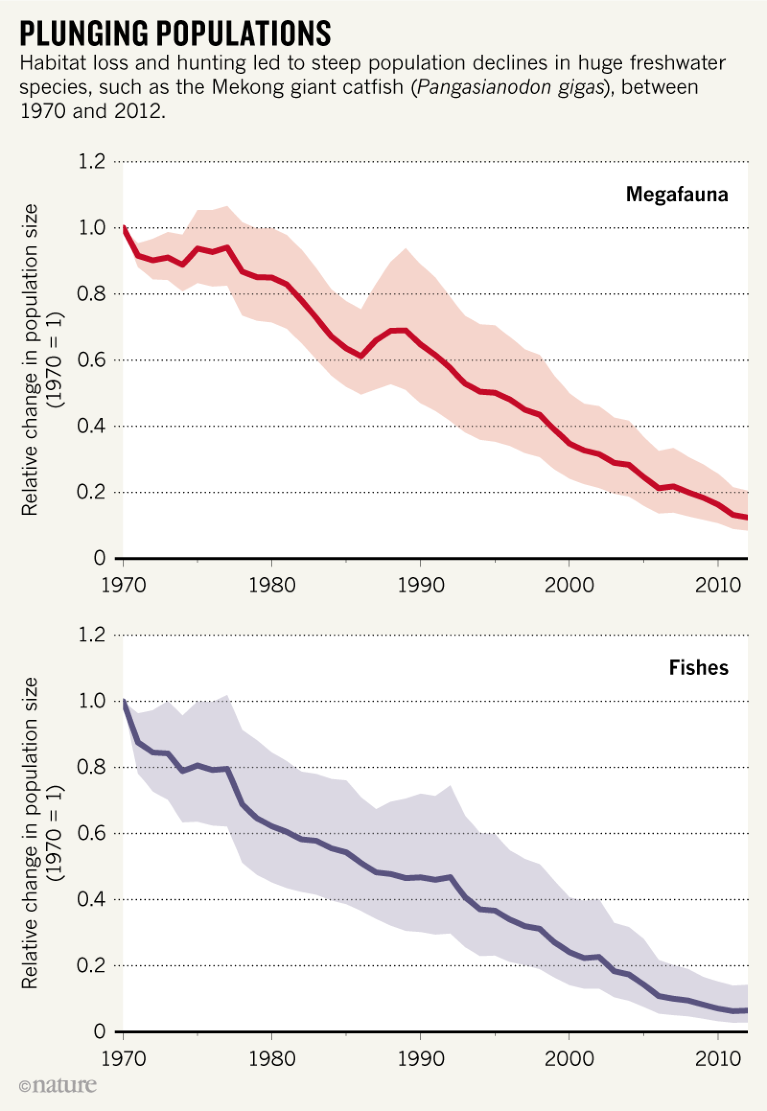EVENTS
Two Ebola drugs show promise in trial Two Ebola drugs have proved so effective in a clinical trial that researchers will make the treatments available to anyone infected with the virus in the Democratic Republic of the Congo (DRC), where Ebola has killed nearly 1,900 people over the past year. The survival rate for people who received either drug shortly after infection, when levels of the virus in their blood were low, was 90%, officials with the World Health Organization and the US and DRC governments said on 12 August. One of the drugs, REGN-EB3, is a cocktail of three monoclonal antibodies against Ebola made by Regeneron Pharmaceuticals in Tarrytown, New York. The second, mAb114, is derived from a single antibody recovered from the blood of a person who survived Ebola in the DRC in 1995, and was developed by the US National Institute of Allergy and Infectious Diseases. The trial of the drugs, and two others, began last November.

Health workers treat a woman whose husband died of Ebola.Credit: Jerome Delay/AP/Shutterstock
Drug data Manipulated data have tainted the approval of a gene therapy widely regarded as the most expensive drug in the world. But the US Food and Drug Administration (FDA) said on 6 August that it should remain on the market while the agency assesses the situation. In May, the FDA approved Zolgensma (onasemnogene abeparvovec-xioi) to treat the most severe form of spinal muscular atrophy, a leading genetic cause of infant death. Before the approval, the company that developed the drug, AveXis of Bannockburn, Illinois, had discovered manipulated data in animal studies performed to help establish a production process. AveXis, now owned by Swiss pharmaceutical giant Novartis, did not disclose the finding until 28 June. In a statement, Novartis said that the delay was to allow for an internal investigation, and that the data in question are limited to an older process no longer used to produce the therapy. Treatment with Zolgensma costs more than US$2 million.
ENVIRONMENT
Running dry More than one-third of the global population lives in countries under “high” or “extremely high” water stress, according to an analysis by the World Resources Institute (WRI), an environmental think tank in Washington DC. The analysis, released on 6 August, found that 17 countries are extremely water-stressed and each year use more than 80% of their total water supply — from surface and groundwater sources (see go.nature.com/2yxfmxq). The 27 countries under high water stress use 40–80% of their annual supply. The WRI collected more than 50 years of global data on water use and supplies to produce the Aqueduct Water Risk Atlas. The institute found that even countries with low average levels of water stress can have hotspots, with states or regions under extremely high stress. In the United States, which ranks 71st on the WRI’s list, New Mexico’s level of water stress is on a par with that of Eritrea.
PUBLISHING
Elsevier dispute At least 30 professors at the University of California (UC) system have stepped down from the editorial boards of Elsevier’s flagship journals because of a disagreement over open access. Negotiations to renew the institution’s subscriptions to the publishing giant’s journals broke down in February owing to a dispute about the cost of making UC-produced research papers freely available. Last month, Elsevier cut off UC academics’ access to new papers published in its journals. In a letter on 7 August, prominent UC researchers, including CRISPR pioneer Jennifer Doudna and Nobel prizewinner Elizabeth Blackburn, said that they would no longer provide editorial services for Elsevier’s 28 Cell Press journals until a new contract is signed.
SPACE
Moon bears The Israeli spacecraft Beresheet, which crash-landed on the Moon in April, delivered thousands of millimetre-sized tardigrades (pictured) to the lunar surface, it emerged this week. The hardy creatures, also known as water bears, were part of an archive created by the Arch Mission Foundation, a non-profit organization in Los Angeles, California, that aims to preserve a backup of Earth’s culture and species. The foundation says that calculations of the likely energy of the crash suggest that the DVD-sized archive, which is stronger than a ‘black box’ flight recorder, probably survived intact. Ultraviolet radiation on the Moon would kill the tardigrades. But if they remain in the archive or are buried, they might survive in a desiccated state, from which they can later be revived. Unlike Mars, the Moon is thought to be inhospitable to life, and no protections exist to prevent spacecraft from contaminating its surface.

Tiny aquatic invertebrates called tardigrades are thought to have crash-landed on the Moon on the Israeli craft Beresheet.Steve Gschmeissner/Getty
POLICY
Science visas The United Kingdom will develop a new fast-track visa route for scientists, Prime Minister Boris Johnson said on 8 August. The government is exploring measures such as abolishing a cap on the Exceptional Talent visa route, and removing the need for scientists to hold a job offer before arriving in Britain. (Nature found in 2018 that the Exceptional Talent visa route was vastly underused.) Science leaders welcomed the move but stressed that Brexit remained overwhelmingly negative for research. Half of all foreign academic scientists in the United Kingdom are from the European Union and do not require a visa to enter or work. The government also pledged to make up some EU research funding that would be lost if the United Kingdom leaves the EU without a deal on 31 October. It said that it would assess UK funding applications under review by the EU on that date, and fund those deemed successful. The funding could be worth €600 million (US$672 million) to UK scientists, says Universities UK, which represents the country’s universities.
PEOPLE
Science minister South Korea’s President Moon Jae-in has nominated Choi Ki-young, who leads an effort to create semiconductor chips that mimic how the brain works, to be minister of science, information and communication technologies. Choi’s nomination comes amid growing tensions between South Korea and Japan. In July, Japan imposed export restrictions on materials such as photoresists and hydrogen fluoride, which are crucial to South Korea’s semiconductor and electronic-display industries. Choi said he felt a “heavy responsibility” in assuming the position given the situation with Japan, according to Yonhap News Agency.
FACILITIES
Lab closure The US Army Medical Research Institute of Infectious Diseases (USAMRIID), which studies dangerous pathogens such as Ebola and plague, has halted operations indefinitely after government inspectors found problems with its wastewater disposal systems and personnel-certification records. On 18 July, inspectors from the US Centers for Disease Control and Prevention (CDC) sent a letter to the laboratory in Fort Detrick, Maryland, ordering it to immediately suspend all research with dangerous pathogens and toxins. The closure was first reported by Maryland local newspaper The Frederick News-Post on 2 August. A USAMRIID spokesperson said that no infectious agents had been detected outside the containment areas, and that the facility is “continuing to work closely with the CDC on corrective actions”.
FUNDING
UK university grants An inquiry by the UK House of Lords has found that funding for research at universities is under threat. In a report published on 8 August, the Lords Science and Technology Committee told the UK government that the ‘block grant’ for universities — money awarded to institutions for research on the basis of the quality of their work — has fallen by 13% in real terms since 2010. It added that a recommendation in May to cut university tuition fees would have severe financial consequences for science, because other income streams that support research would be diverted to make up for the shortfall in teaching funds. The committee urged the government to address the deficit in research funding.
TREND WATCH
Freshwater megafishes — giants weighing more than 30 kilograms that can live for decades — declined by more than 94% between 1970 and 2012, according to a study. The findings, published on 8 August in the journal Global Change Biology, are part of an analysis that looked at the populations of enormous freshwater animals in the world’s rivers and lakes. The drop-off reflects a broader downward trend in the populations of freshwater megafauna — such as caimans, giant salamanders and giant catfish — around the world. The study authors collected data on the populations of 126 large freshwater species from 72 countries, and estimate that the populations of big freshwater animals have fallen by 88%. They expected megafishes to be hit the hardest by human activities such as overfishing and loss of habitat, because many giant fish species mature late, have relatively few offspring and require large, intact habitats for migration. Their movements are increasingly hampered by hydroelectric dams in the world’s greatest river basins, such as the Mekong, Congo, Amazon and Ganges.

Source: F. He et al. Glob. Change Biol. https://doi.org/10.1111/gcb.14753 (2019).






